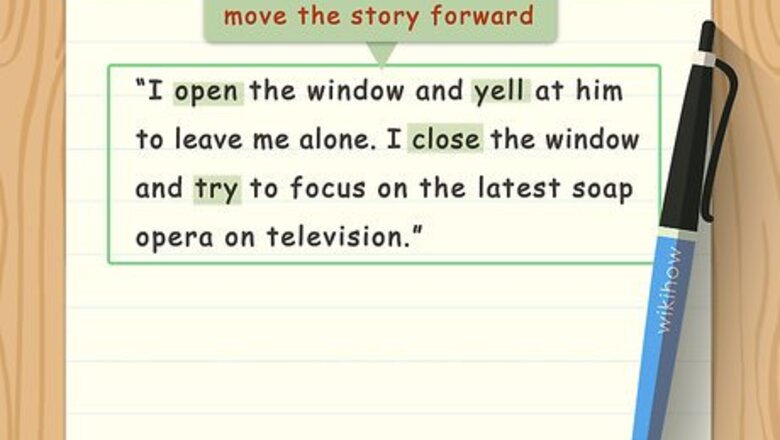
views
Choosing a Tense for the First Person Narrative
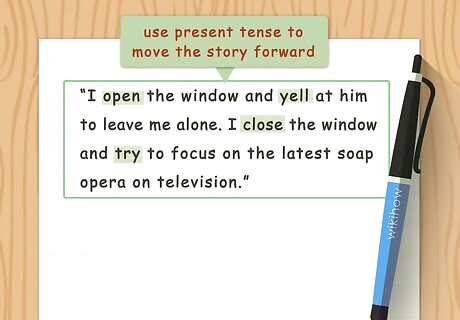
Use present tense to move the story forward. The first person point of view has two different tenses, present tense and past tense. Present tense “I” focuses on the actions and thoughts of the narrator as they unfold in the present. It can be a good option for moving the story forward, carrying the reader through a narrative as events and moments are happening. For example, a first person present tense narrator would be, “I open the window and yell at him to leave me alone. I close the window and try to focus on the latest soap opera on television.”
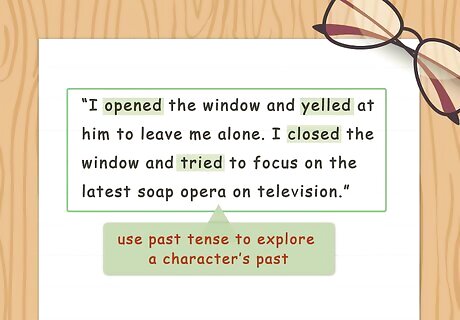
Try past tense to explore a character’s past. The past tense is a good option if you are writing a story that explores the main character or narrator’s past. It is a more popular tense than present tense and is often easier to do. Writing in the past tense can make the story feel more like it is being told, rather than happening in the present moment. For example, a first person past tense narrator would be, “I opened the window and yelled at him to leave me alone. I closed the window and tried to focus on the latest soap opera on television.”
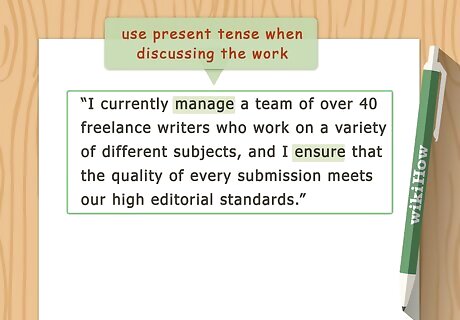
Go for present tense when discussing the work. In most cases, the first person point of view is not recommended for an academic essay. But your instructor may allow you use the first person when discussing a work of literature or a scholarly work. Use the present tense to give the discussion immediacy and an intimate tone. If you are using APA style, you can use the first person point of view to discuss your research steps in a research paper. For example, you may write, “I studied sample A” or “I interviewed subject B.” In general, you should avoid the first person point of view and only use it sparingly in your research paper.
Using the First Person to Build Character
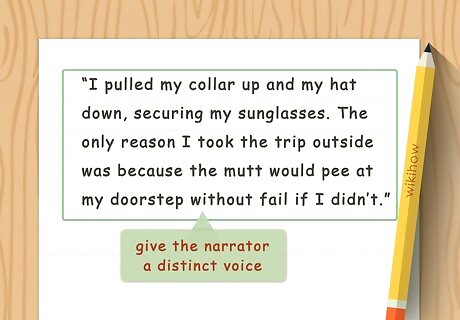
Give the narrator a distinct voice. First person narrators often have a particular way of seeing the world, which is based on their backstory. Give your first person narrator a narrative voice that is distinct and particular to them. Consider the narrator’s age, class, and background. Use these elements to create the voice of the first person narrator. For example, if your narrator is a Latino teenager who lives in the Bronx, they will have a distinct narrative voice that may use Spanish phrases and teenage slang as well as standard English.
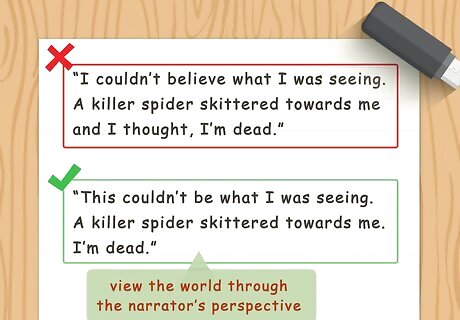
Filter the actions of the story through the narrator. With a first person narrator, you want the reader to view the world of the story through their perspective. This means describing scenes, other characters, and settings from the point of the view of the narrator. Try to filter all the action in the story through the first person narrator so the reader gets a sense of their point of view. For example, rather than say, “I couldn’t believe what I was seeing. A killer spider skittered towards me and I thought, I’m dead,” focus on describing the action straight from the viewpoint of the narrator. You may write, “This couldn’t be what I was seeing. A killer spider skittered towards me. I’m dead.”
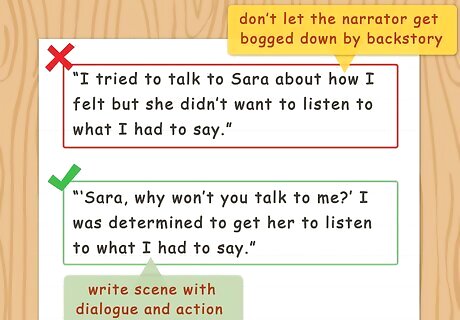
Use the “I” to keep the pace and action moving forward. Try not to let the first person narrator get bogged down by backstory or long descriptions, especially if you’re writing in the present tense. Keep the pace and action of the story moving forward. Focus on keeping your narrator in the action in every scene. For example, rather than write, “I tried to talk to Sara about how I felt but she didn’t want to listen to what I had to say,” you may put this content in a scene with dialogue and action. You may write instead, “‘Sara, why won’t you talk to me?’ I was determined to get her to listen to what I had to say.”

Read examples of first person narratives. To get a better sense of the first person point of view, read examples of this perspective in literature. Look at present and past tense examples so you can look at how other writers use it in their work. There are several well known examples of the first person point of view in writing, including: To Kill a Mockingbird by Harper Lee Moby Dick by Herman Melville The Great Gatsby by F. Scott Fitzgerald Lucy by Jamaica Kincaid "Shooting an Elephant," an essay by George Orwell "The Death of the Moth," an essay by Virginia Woolf
Avoiding the Pitfalls of First Person
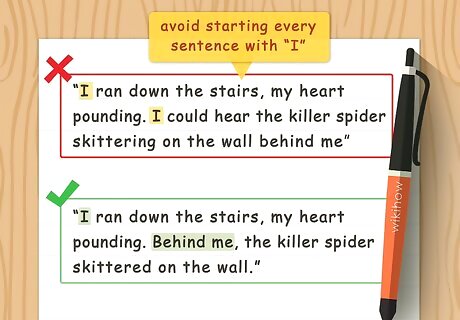
Avoid starting every sentence with “I.” Though you are writing from the perspective of the “I” in the first person point of view, you do not want every sentence to begin with “I.” Doing this can make the narrative feel repetitive and stilted. Try to vary up your sentences so you do not start with “I” in every sentence or have “I” in sentence after sentence. For example, rather than have two sentences like, “I ran down the stairs, my heart pounding. I could hear the killer spider skittering on the wall behind me,” you can write, “I ran down the stairs, my heart pounding. Behind me, the killer spider skittered on the wall.”
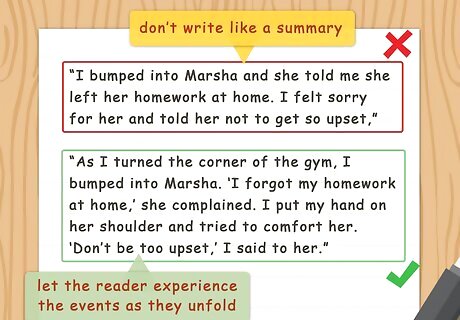
Do not report on the action using the “I.” Allow the first person narrator to describe a scene or moment from their point of view. Do not use the passive voice when describing a scene or moment through your first person narrator. This can make the narrative sound like a report or a summary of events, rather than let the reader experience the events as they unfold. For example, rather than write, “I bumped into Marsha and she told me she left her homework at home. I felt sorry for her and told her not to get so upset,” you may place the reader right in a scene. You may write, “As I turned the corner of the gym, I bumped into Marsha. ‘I forgot my homework at home,’ she complained. I put my hand on her shoulder and tried to comfort her. ‘Don’t be too upset,’ I said to her.”
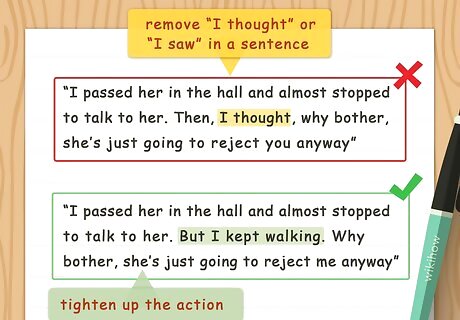
Try not to place distance between the reader and the “I.” Using “I thought,” “I saw,” or “I felt” in the narrative can create distance between the reader and the first person perspective. For example, rather than write, “I felt sad about losing her as a friend,” you may write, “Sadness filled my body as I realized I was losing her as a friend.” You can also often simply remove “I thought” or “I saw” in a sentence to make the first person point of view stronger. For example, rather than write, “I passed her in the hall and almost stopped to talk to her. Then, I thought, why bother, she’s just going to reject you anyway,” remove "I thought" and tighten up the action in the sentence. You may write, “I passed her in the hall and almost stopped to talk to her. But I kept walking. Why bother, she’s just going to reject me anyway.”
Polishing the First Person Narrative

Read the piece out loud. Once you have completed a draft of the story in the first person, read it out loud. Listen to how each sentence sounds in the narrative. Notice if you repeat “I” too often or in every sentence. Pay attention to the voice of the first person narrator and note if it feels consistent throughout the piece. You should also pay attention to the tense in the story. Make sure the story does not shift from present to past tense or vice versa. It should stay in the same tense the entire time.
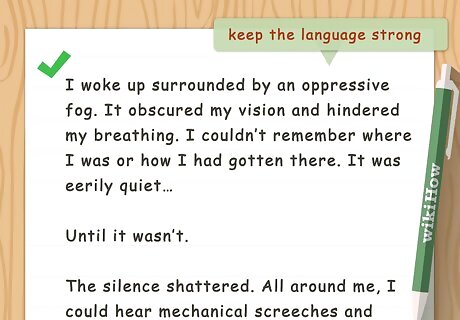
Tighten up the word choice and language. As you polish and revise the story, make sure your word choice and language is strong. Look for any words that you can replace with more unique terms. Check for any language that does not feel as clear or concise as it could be. Make sure your word choice and language suit the first person narrator in the story.

Show the piece to others. You should show your draft to others and get their feedback. Ask friends and peers to read the first person narrative. Have them give you feedback and apply their critiques to the story to make it stronger. You may also show the story to a writing group to get their criticisms and critiques. Be open to the feedback of others and use it to improve the first person narrator in your story.



















Comments
0 comment